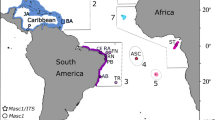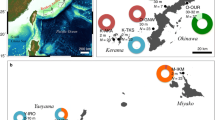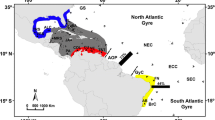Abstract
The red coral Corallium rubrum (Cnidaria, Octocorallia) is an exploited, long-lived sessile species from the Mediterranean Sea and the adjacent coastline in the Atlantic Ocean. Surveys of genetic variation using microsatellites have shown that populations of C. rubrum are characterized by strong differentiation at the local scale but a study of the phylogeography of this species was still lacking. Here, we used seven polymorphic microsatellite loci, together with sequence data from an intron of the elongation factor 1 (EF1) gene, to investigate the genetic structure of C. rubrum across its geographical range in the western Mediterranean Sea and in the Adriatic Sea. The EF1 sequences were also used to analyse the consequences of demographic fluctuations linked with past environmental change. Clustering analysis with microsatellite loci highlighted three to seven genetic groups with the distinction of North African and Adriatic populations; this distinction appeared significant with AMOVA and differentiation tests. Microsatellite and EF1 data extended the isolation by distance pattern previously observed for this species at the western Mediterranean scale. EF1 sequences confirmed the genetic differentiation observed between most samples with microsatellites. A statistical parsimony network of EF1 haplotypes provided no evidence of high sequence divergence among regions, suggesting no long-term isolation. Selective neutrality tests on microsatellites and EF1 were not significant but should be interpreted with caution in the case of EF1 because of the low sample sizes for this locus. Our results suggest that recent Quaternary environmental fluctuations had a limited impact on the genetic structure of C. rubrum.




Similar content being viewed by others
References
Abbiati M, Santangelo G, Novelli S (1993) Genetic variation within and between two Tyrrhenian populations of the Mediterranean alcyonarian Corallium rubrum. Mar Ecol Prog Ser 95:245–250
Avise JC (2000) Phylogeography: the history and formation of species. Harvard University Press, Cambridge
Bahri-Sfar L, Lemaire C, Ben Hassine OK, Bonhomme F (2000) Fragmentation of sea bass populations in the western and eastern mediterranean as revealed by microsatellite polymorphism. Proc R Soc Lond B 267:929–935
Belkhir K, Borsa P, Chikhi L, Raufaste N, Bonhomme F (1996–2004) GENETIX 4.05, logiciel sous Windows TM pour la génétique des populations. Laboratoire Génome, Populations, Interactions, CNRS UMR 5000, Université de Montpellier II, Montpellier (France). http://www.genetix.univ-montp2.fr/genetix/genetix.htm
Benjamini Y, Hochberg Y (1995) Controlling the false discovery rate—A practical and powerful approach to multiple testing. J R Statist Soc B 57:289–300
Borsa P, Naciri M, Bahri L, Chikhi L, Garcia de Leon FJ, Kotoulas G, Bonhomme F (1997) Intraspecific zoogeography of the Mediterranean: population genetic analysis on sixteen atlanto-mediterranean species (fish and invertebrates). Vie Milieu 47:295–305
Calderón I, Garrabou J, Aurelle D (2006) Evaluation of the utility of COI and ITS markers as tools for population genetic studies of temperate gorgonians. J Exp Mar Biol Ecol 336:184–197
Castric V, Bernatchez L (2003) The rise and fall of isolation by distance in the anadromous brook charr (Salvelinus fontinalis Mitchill). Genetics 163:966–983
Chaoui L, Hichem Kara M, Quignard J-P, Faure E, Bonhomme F (2009) Forte différenciation génétique de la daurade Sparus aurata (L., 1758) entre les deux rives de la Méditerranée occidentale. C R Biol 332:329–335
Clement M, Posada D, Crandall KA (2000) TCS: a computer program to estimate gene genealogies. Mol Ecol 9:1657–1660
Cornuet JM, Luikart G (1996) Description and power analysis of two tests for detecting recent population bottlenecks from allele frequency data. Genetics 144:2001–2014
Costantini F, Abbiati M (2006) Development of microsatellite markers for the Mediterranean gorgonian coral Corallium rubrum. Mol Ecol Notes 6:521–523
Costantini F, Fauvelot C, Abbiati M (2007a) Fine-scale genetic structuring in Corallium rubrum: evidence of inbreeding and limited effective larval dispersal. Mar Ecol Prog Ser 340:109–119
Costantini F, Fauvelot C, Abbiati M (2007b) Genetic structuring of the temperate gorgonian coral (Corallium rubrum) across the western Mediterranean Sea revealed by microsatellites and nuclear sequences. Mol Ecol 16:5168–5182
Costantini F, Taviani M, Remia A, Pintus E, Schembri J, Abbiati M (2010) Deep-water Corallium rubrum (L., 1758) from the Mediterranean Sea: preliminary genetic characterisation. Mar Ecol 31:261–269
del Gaudio D, Fortunato G, Borriello M, Gili JM, Buono P, Calcagno G, Salvatore F, Sacchetti L (2005) Genetic typing of Corallium rubrum. Mar Biotech 6:511–515
Duran S, Giribet G, Turon X (2004) Phylogeographical history of the sponge Crambe crambe (porifera, poecilosclerida): range expansion and recent invasion of the Macaronesian islands from the Mediterranean Sea. Mol Ecol 13:109–122
Evanno G, Regnaut S, Goudet J (2005) Detecting the number of clusters of individuals using the software STRUCTURE: a simulation study. Mol Ecol 14:2611–2620
Excoffier L, Smouse PE, Quattro JM (1992) Analysis of molecular variance inferred from metric distances among DNA haplotypes: application to human mitochondrial DNA restriction data. Genetics 131:479–491
Excoffier L, Laval G, Schneider S (2005) Arlequin (version 3.0): an integrated software package for population genetics data analysis. Evol Bioinform Online 1:47–50
Eytan R, Hayes M, Arbour-Reily P, Miller M, Hellberg M (2009) Nuclear sequences reveal mid-range isolation of an imperilled deep-water coral population. Mol Ecol 18:2375–2389
Falush D, Stephens M, Pritchard JK (2003) Inference of population structure using multilocus genotype data: linked loci and correlated allele frequencies. Genetics 164:1567–1587
Faure B, Bierne N, Tanguy A, Bonhomme F, Jollivet D (2007) Evidence for a slightly deleterious effect of intron polymorphisms at the EF1α gene in the deep-sea hydrothermal vent bivalve bathymodiolus. Gene 406:99–107
Faure M, David P, Bonhomme F, Bierne N (2008) Genetic hitchhiking in a subdivided population of Mytilus edulis. BMC Evol Biol 8:164
Féral JP (2002) How useful are the genetic markers in attempts to understand and manage biodiversity? J Exp Mar Biol Ecol 268:121–145
Frantz A, Cellina S, Krier A, Schley L, Burke T (2009) Using spatial bayesian methods to determine the genetic structure of a continuously distributed population: clusters or isolation by distance? J Appl Ecol 46:493–505
Fu YX (1997) Statistical tests of neutrality of mutations against population growth, hitchhiking and background selection. Genetics 147:915–925
Garrabou J, Harmelin JG (2002) A 20-year study on life-history traits of a harvested long-lived temperate coral in the NW Mediterranean: insights into conservation and management needs. J Anim Ecol 71:966–978
Garrabou J, Coma R, Bensoussan N, Chevaldonné P, Cigliano M et al (2009) Mass mortality in NW Mediterranean rocky benthic communities: effects of the 2003 heat wave. Glob Change Biol 15:1090–1103
Hall TA (1999) BioEdit: a user-friendly biological sequence alignment editor and analysis program for Windows 95/98/NT. Nucl Acids Symp Ser 41:95–98
Hayes A, Kucera M, Kallel N, Sbaffi L, Rohling EJ (2005) Glacial mediterranean sea surface temperatures based on planktonic foraminiferal assemblages. Quat Sci Rev 24:999–1016
Hewitt G (2000) The genetic legacy of the quaternary ice ages. Nature 405:907–913
Jensen J, Bohonak A, Kelley S (2005) Isolation by distance, web service. BMC Genet 6:1–6
Jost L (2008) GST and its relatives do not measure differentiation. Mol Ecol 17:4015–4026
Kalinowski ST (2011) The computer program STRUCTURE does not reliably identify the main genetic clusters within species: simulations and implications for human population structure. Heredity 106:625–632
Lambeck K, Bard E (2000) Sea-level change along the French Mediterranean coast for the past 30 000 years. Earth Planet Sci Lett 175:203–222
Ledoux JB, Mokthar-Jamaï K, Roby C, Féral JP, Garrabou J, Aurelle D (2010a) Genetic survey of shallow populations of the Mediterranean red coral (Corallium rubrum (Linnaeus, 1758)): new insights into evolutionary processes shaping nuclear diversity and implications for conservation. Mol Ecol 19:675–690
Ledoux JB, Garrabou J, Bianchimani O, Drap P, Féral JP, Aurelle D (2010b) Fine-scale genetic structure and inferences on population biology in the threatened Mediterranean red coral, Corallium rubrum. Mol Ecol 19:4204–4216
Li N, Stephens M (2003) Modelling linkage disequilibrium and identifying recombination hotspots using single-nucleotide polymorphism data. Genetics 165:2213–2233
Librado P, Rozas J (2009) DnaSP v5: a software for comprehensive analysis of DNA polymorphism data. Bioinformatics 25:1451–1452
Maggs CA, Castilho R, Foltz D, Henzler C, Taimour Jolly M, Kelly J, Olsen J, Perez KE, Stam W, Väinölä R, Viard F, Wares J (2008) Evalutating signatures of glacial refugia for north atlantic benthic marine taxa. Ecology 89:S108–S122
Marko P, Hoffman J, Emme S, McGovern T, Keever C, Cox L (2010) The “expansion-contraction” model of pleistocene biogeography: rocky shores suffer a sea change? Mol Ecol 19:146–169
Moritz C (2002) Strategies to protect biological diversity and the evolutionary processes that sustain it. Syst Biol 51:238–254
Nei M (1987) Molecular evolutionary genetics. Columbia University Press, New York
Orloci L (1978) Multivariate analysis in vegetation research. Dr W Junk BV, The Hague
Patarnello T, Volckaert FAMJ, Castilho R (2007) Pillars of Hercules: is the Atlantic-Mediterranean transition a phylogeographical break? Mol Ecol 16:4426–4444
Peakall R, Smouse PE (2006) GENALEX 6: genetic analysis in Excel. Population genetic software for teaching and research. Mol Ecol Notes 6:288–295
Petit RJ, Aguinagalde I, de Beaulieu J, Bittkau C, Brewer S, Cheddadi R et al (2003) Glacial refugia: hotspots but not melting pots of genetic diversity. Science 300:15S63–15S1565
Piry S, Luikart G, Cornuet JM (1999) BOTTLENECK: a computer program for detecting recent reductions in the effective population size using allele frequency data. J Hered 90(4):502–503
Pritchard JK, Stephens M, Donnelly P (2000) Inference of population structure using multilocus genotype data. Genetics 155:945–959
Pritchard J, Wen X, Falush D (2007) Documentation for structure software: version 2.2
Ramírez-Soriano A, Ramos-Onsins SE, Rozas J, Calafell F, Navarro A (2008) Statistical power analysis of neutrality tests under demographic expansions, contractions and bottlenecks with recombination. Genetics 179:555–567
Ramos-Onsins SE, Rozas J (2002) Statistical properties of new neutrality tests against population growth. Mol Biol Evol 19:2092–2100
Rousset F (1997) Genetic differentiation and estimation of gene flow from F-statistics under isolation by distance. Genetics 145:1219–1228
Rozen S, Skaletsky HJ (2000) Primer3 on the WWW for general users and for biologist programmers. In: Krawetz S, Misener S (eds) Bioinformatics methods and protocols: methods in molecular biology. Humana Press, Totowa, pp 365–386
Ruggiero M, Turk R, Procaccini G (2002) Genetic identity and homozygosity in north-adriatic populations of Posidonia oceanica: an ancient, post-glacial clone? Cons Gen 3:71–74
Santangelo G, Bramanti L, Iannelli M (2007) Population dynamics and conservation biology of the over-exploited Mediterranean red coral. J Theo Biol 244:416–423
Serra IA, Innocenti AM, Di Maida G, Calvo S, Migliaccio M, Zambianchi E et al (2010) Genetic structure in the Mediterranean seagrass Posidonia oceanica: disentangling past vicariance events from contemporary patterns of gene flow. Mol Ecol 19:557–568
Städler T, Haubold B, Merino C, Stephan W, Pfaffelhuber P (2009) The impact of sampling schemes on the site frequency spectrum in nonequilibrium subdivided populations. Genetics 182:205–216
Stephens M, Scheet P (2005) Accounting for decay of linkage disequilibrium in haplotype inference and missing data imputation. Am J Hum Gen 76:449–462
Stephens M, Smith NJ, Donnelly P (2001) A new statistical method for haplotype reconstruction from population data. Am J Hum Gen 68:978–989
Tajima F (1989) Statistical method for testing the neutral mutation hypothesis by DNA polymorphism. Genetics 123:585–595
Tatarenkov A, Healey CIM, Avise JC (2010) Microgeographic population structure of green swordail fish: genetic differentiation despite abundant migration. Mol Ecol 19:257–268
Thiede J (1978) A glacial Mediterranean. Nature 276:680–683
Vertino A, Zibrowius H, Taviani M (2010) Fossil ancestors of family Coralliidae in the Mediterranean Sea. In: Bussoletti E, Cottingham D, Bruckner A, Roberts G and Sandulli R (eds) Proceedings of the international workshop on red coral science, management, and trade: lessons from the Mediterranean. NOAA Technical Memorandum CRCP-13, Silver Spring, MD, pp 94–98
Viard F, Franck P, Dubois M, Estoup A, Jarne P (1998) Variation of microsatellite size homoplasy across electromorphs, loci, and populations in three invertebrate species. J Mol Evol 47:42–51
Vighi M (1972) Etude sur la reproduction du Corallium rubrum (L.). Vie et milieu 23:21–32
Weinberg S (1979) The light-dependent behaviour of planula larvae of Eunicella singularis and Corallium rubrum and its implication for octocorallian ecology. Bijdragen tot de Dierkunde 49:16–30
Weir B, Cockerham C (1984) Estimating F-statistics for the analysis of population structure. Evolution 38:1358–1370
Zibrowius H, Monteiro Marques V, Grasshoff M (1984) La répartition du Corallium rubrum dans l’Atlantique (Cnidaria: Anthozoa: Gorgonaria). Téthys 11:163–170
Acknowledgments
We thank Joaquim Garrabou, Olivier Bianchimani, Christian Marschal, Pierre Chevaldonné, Frédéric Zuberer, Roland Graille and Thierry Pérez for providing samples and Didier Forcioli and Helmut Zibrowius for useful comments. We thank Charlotte Roby, Kenza Mokhtar-Jamaï, Emmanuelle Renard, Carole Borchiellini, Emilie Egea, Gwilherm Penant, Eve Gazave and Pascal Lapébie for their help in the laboratory. This work was funded by the French ANR (National Research Agency) in the Medchange program (www.medchange.org). This was also part of the EPIC project in the European Union Network of Excellence Marine Genomics. Some samples were obtained through the GBIRM project in the European Union Network of Excellence MARBEF. J.-B.L’s PhD was funded by the Région Provence Alpes Côte d’Azur. Two anonymous reviewers helped us to improve previous versions of this article.
Author information
Authors and Affiliations
Corresponding author
Electronic supplementary material
Below is the link to the electronic supplementary material.
Rights and permissions
About this article
Cite this article
Aurelle, D., Ledoux, JB., Rocher, C. et al. Phylogeography of the red coral (Corallium rubrum): inferences on the evolutionary history of a temperate gorgonian. Genetica 139, 855–869 (2011). https://doi.org/10.1007/s10709-011-9589-6
Received:
Accepted:
Published:
Issue Date:
DOI: https://doi.org/10.1007/s10709-011-9589-6




